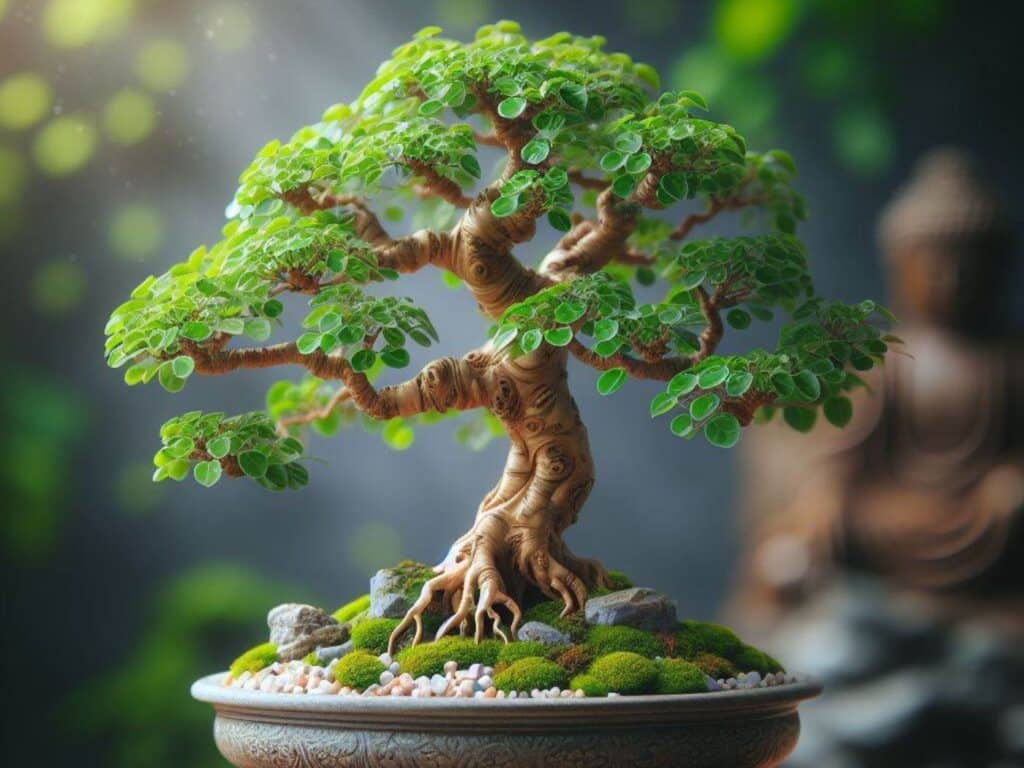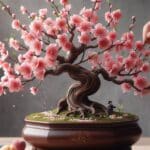Do you want to grow a beautiful bodhi tree? This type of bonsai can add charm and color to your interior spaces since it produces bright red to green colored foliage, and the leaves have an adorable heart shape.
Bosnia enthusiasts love to grow this tree because it can produce exciting stem patterns and areal roots. It is also beloved because the tree has many special meanings and is often used as a powerful symbol in Buddhism.
In this guide, we will show you exactly how to grow the sacred fig tree and keep it healthy and happy inside your home.
Plant Facts
| Scientific name | Ficus Religiosa |
| Common names | bodhi tree, Bo-Tree, Sacred fig tree, Peepul |
| Family | Moraceae |
| Plant Type | Ornamental Tree |
| Height and Width | 60 – 100 ft. tall (natural), 1–5 ft. tall (bonsai) |
| Origin | Southeast Asia, Southwest China, India, and Himalayan foothills |
| Flower colors | Red or pink flowers with green or red fruits |
| Foliage color | Redish to dark green |
| Sun Exposure | Indirect light, partial light, or bright sunlight |
| Soil Type & pH | Well-drained loose soil |
| Special features | Low Maintenance, Good for containers, can withstand dry spells, quick growth rate |
What Does a bodhi Bonsai Look Like
This exciting specimen plant is easy to identify by its heart-shaped foliage. The foliage starts in vibrant reddish colors and eventually turns green as the tree matures. Sacred fig bonsai has a light grey bark, and these trees are often grown with multiple trunks. The tree might also produce aerial roots, giving it a more exciting appearance.
These semi-evergreens can stay vibrant green throughout the year in warmer climates but can shed their leaves in colder areas.

Where Does a bodhi Bonsai Grow
This sacred tree enjoys lots of indirect sunlight or filtered sunlight. It should be kept out of direct sunlight, especially on hot and sunny days.
The tree isn’t cold tolerant and should be moved indoors to protect it from the frost.
Finding a permanent spot for this type of tree is best since they prefer to be moved around sparingly. If the tree is suddenly moved to a different spot, it might lose its foliage.
How to Grow a Bonsai Bodhi Tree
The sacred fig bonsai is very popular among enthusiasts because it is relatively easy to grow. Let’s take a quick look at how to grow and develop this type of bonsai.
Propagation
Bodhi bonsai can easily grow from seeds, stem cuttings, or marcotting. Getting some seeds for this tree can be challenging since they rarely bloom or bear fruits.
Most people like to plant them from stem cuttings because the cutting is already thickened and strong, giving your tree a head start over seedlings.
Soil
This type of bonsai tree can sometimes be drought tolerant but needs to handle waterlogged conditions better. If the roots are kept moist, the tree will develop root rot.
Planting this mini tree in a light bonsai soil mixture with lots of loose sand or gravel so moisture can quickly drain away.
Pruning
The ficus religiosa bonsai should be pruned regularly because it can quickly outgrow its shape. It is usually best to prune your little tree in early spring before the growing season.
While pruning this tree, you can remove any unwanted or diseased stems and overly large leaves. Ingrown stems can also be cleared away so the main branches can be appreciated.
Some bonsai artists like to completely defoliate the bodhi bonsai in early spring. This process involves removing all the foliage so new and smaller leaves can develop. Defolication should only be done if the tree is healthy and strong, or it might cause damage to your plant.
The tree can also be lightly pruned throughout the growing season to maintain a good shape.
Bonsai artists often wrap the stems and branches in aluminum or copper bonsai wire. This will allow you to bend the branches or stems into different shapes to create a specific bonsai style.
Reptting and Transplanting
This type of tree is usually repotted in a bonsai pot when the trunk is 1 inch thick. They can be planted in a shallow bonsai pot with many drainage holes.
While repotting the tree, you should be careful to trim the roots to ¼ of the tree’s height.
Plant the little tree in fresh bonsai soil and keep it nice and moist for about two weeks so the root system can recover.
How to Care for a Bodhi Bonsai
It is relatively easy to keep this tree in good health. Here is a quick look at how to take good care of this type of miniature tree.
Water
This tree can grow well in moist conditions but it shouldn’t be overwatered. It can be a good bonsai for beginners since the plant can survive short dry spells in case you forget to water it. The best way to keep this type of tree healthy is by waiting until the soil has completely dried out before watering it again.
Sunlight
This indoor bonsai prefers bright indirect sunlight. You should keep it in a sunny window or on a sunny patio where it will get lots of partial or indirect light. This tropical tree won’t tolerate cold climates and should be protected from cold winds or low temperatures during winter time.
Temperature and Humidity
Bodhi trees prefer tropical and humid conditions. If you want your little tree to develop stunning aerial roots, you should keep it in a warm area with high humidity levels.
You can mist the plant daily or place it in a pebble tray with water to raise the humidity levels. This is especially important if the tree is kept indoors throughout the year.
Fertilizer
Bonsai trees are planted in small containers and have limited resources. To keep the tree healthy, you must fertilize it once a week during its growing season and once a month during winter. It is best to use a fertilizer with a mixture of nitrogen, potassium, and phosphorus with a 3.2.1 ratio for these trees. However, any nitrogen-rich fertilizer should work very well.
Pests and Diseases
You don’t have to worry too much about protecting this tree from pests or diseases. The tree species is highly resilient against pests and isn’t too vulnerable.
The biggest challenge with these types of trees is to keep the root nice and dry so the tree won’t develop root rot.
Conclusion
Growing a sacred fig tree can be an advantageous experience. This tree is ideal for beginner or intermediate bonsai artists because it is pretty hardy, resilient to pests, withstands heavy pruning, and is relatively easy to maintain.
It is an excellent bonsai to grow if you want to create bonsai with a Buddhist theme since the tree has a significant meaning in this religion.
We hope you enjoyed our growing guide and wish you all the best with growing and caring for this attractive plant.
Up next:







